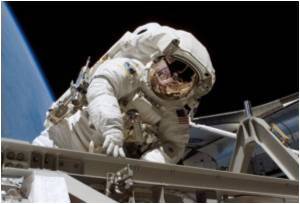Maintaining a constant supply of food for the astronauts, is an issue that continues to be a challenge for the NASA scientists. Going to the moon and returning back is fine as these are short haul space flights but taking longer trips to Mars and beyond is a completely different challenge. Space food system has developed a considerably over the last five decades but researchers continue to look at methods of fulfilling the requirements for longer flights. Astronauts, just like any of us, eat breakfast, lunch and dinner and they can choose from many types of foods such as fruits, nuts, beef, chicken, seafood, and yes, even brownies. They drink coffee, tea, orange juice, fruit punches and lemonade. What the nutritionists have to ensure is that the food the astronauts eat provides them with a balanced supply of vitamins and minerals. The food has to be packaged so as not to spoil or lose their nutritional efficacy and safety over a period like 3 to 5 years.
The food technologists and space nutritionists also need to ensure that the food is acceptable in terms of taste, color, odor and feel for the food system to be viable in cases of long-duration missions. In an article entitled - Developing the NASA Food System for Long-Duration Missions in the Journal of Food Science, the authors Cooper, M., Douglas, G. and Perchonok, M. point out the gaps that present barriers to achieving a food system for long exploration missions.Following are the major technological and development needs for the space food system to successfully supply long exploration missions:
- Nutrient-dense, shelf stable foods that meet overall sensory acceptability metrics
- Shelf stable menu items with at least a 5-year shelf life
- Partial gravity cooking processes with minimization of microbial risk
- Sustained vitamin delivery in shelf stable foods
- A packaging material that meets high-barrier, low-mass, and process-compatibility constraints
As regards shelf life, they say, ‘The two technologies with the most promise are high-pressure processing (HPP) and microwave sterilization. Pressure inactivates most vegetative bacteria at pressures above 415 MPa. HPP retains food quality, maintains natural freshness, and extends microbiological shelf life. Microwave sterilization is a high-temperature, short time process in which the packaged food is cooked at 129 °C for 10 min. The current thermo-stabilized NASA food products are cooked to about 121 °C, but for a much longer time. Preliminary studies suggest that the quality of the foods is much higher when these promising technologies are used. More substantive work is needed with these foods to determine the long-term impact of the processing methods on degradation of quality’.
Similarly, once NASA builds extraterrestrial habitats, crew members may be required to harvest hydroponically (cultivating plants in nutrient solution rather than in soil) grown produce, store and repackage ingredients in the foreign environment, and cook with equipment engineered for a partial gravity surface.
The potential contamination points of the food supply will increase unless an equally stringent Hazard Analysis and Critical Control Points (HACCP) plan is applied to the new system. Again, heat and mass transfer are affected by partial gravity and reduced atmospheric pressure. At that pressure, the boiling temperature for water is 82.8 °C. Understanding the physical changes in the environment and the impact to food preparation and processing is critical to estimate the microbial load throughout the cook, quantify the risk of food borne illness, and reduce the risk to acceptable levels.
Another gap in the NASA food system is the vitamin delivery. The investigators feel that the prepackaged food must maintain sufficient nutrient density to supply the necessary micronutrients for 5 years. In addition, the packaging will have to maintain its physical and chemical barrier properties to protect the food. Encapsulated vitamin fortification or new methods of vitamin stabilization may be required to achieve nutrient-rich foods with limited degradation potential.
Last but not the least NASA needs to seek a ‘low-mass, high-barrier packaging material that is compatible with incineration and processing procedures to optimize the resource utilization.’ The ideal material would provide extended protection against oxygen and moisture ingress at ambient conditions but still have the flexibility and sealing capability to fit with large and small pouch production.
Cooper and colleagues lauding the carefully planned research of the NASA’s Advanced Food Technology (AFT) conclude by saying – ‘Without an adequate food system, it is possible that space crewmembers’ health and performance would be compromised. It is clear that in developing adequate NASA food systems for future missions, a balance must be maintained between use of resources (such as power, mass, and crew time), and the safety, nutrition, and acceptability of the food system’.
Reference:Cooper, M., Douglas, G. and Perchonok, M. (2011), Developing the NASA Food System for Long-Duration Missions. Journal of Food Science, 76: R40–R48.
[ http://onlinelibrary.wiley.com/doi/10.1111/j.1750-3841.2010.01982.x/full ]
Source-Medindia















